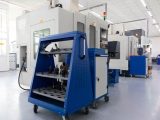
From Shop Floor to Factory Ceiling: Where Lifting Hoists Do Their Best Work
August 5, 2025When it comes to lifting heavy loads, there’s no need to muscle through it. Lifting hoists do the heavy lifting so people don’t have to. These tools are built for safe, repeatable handling of materials across workshops, warehouses, and large production floors. Whether it’s a simple repair station or a towering assembly line, the right hoist keeps things moving, lifting, and landing exactly where needed.
Lifting Hoists on the Ground Floor
Start with the shop floor. This is where lifting hoists often earn their keep. Small workshops use them to move engines, metal components, and heavy fixtures. In tighter spaces where forklifts can’t manoeuvre easily, hoists take over. A fixed frame and a sturdy hook do the job without causing clutter.
Crane hoists in these setups often operate manually or with compact electric motors. This keeps the process efficient without demanding too much from the power supply. A simple chain hoist can lift with ease and precision, especially when used repeatedly throughout the day.
Moving Up in the Warehouse
In storage and logistics spaces, lifting hoists help with vertical movement and provide added directional control. They allow warehouse teams to lift boxes, crates, or palletised goods onto high racks or shelving. Speed matters here, but so does accuracy. One wrong lift can knock things over or damage goods. A crane hoist that can move slowly and steadily wins the day.
For vertical lifts in warehouse settings, the right gear makes a difference. A mobile gantry or fixed overhead beam with a hoist does the job efficiently. The result is less time spent reaching for the top shelf and more time packing orders.
Precision Work on the Assembly Line
Assembly lines are where things get tricky. You’re the same components, parts, and materials again and again, and it has to land perfectly every time. Whether it’s mounting panels, placing machine parts, or lifting tools into position, precision matters more than brute strength.
A crane hoist fitted on a jib arm or workstation rail helps maintain the right pace. Operators can guide parts smoothly into place without wobble or slip. This consistency improves workflow and reduces the chance of errors. It’s about rhythm, not muscle.
High-Ceiling Operations
When the lifting has to go higher, industrial facilities turn to full-scale setups. Think steel plants, shipyards, or logistics depots with overhead rails running the length of the building. Here, lifting hoists mounted on bridge cranes do the heavy work. They handle tons of material and still provide the control needed to stop at the right spot.
This is where a dependable crane supplier in Singapore comes into play. The equipment has to be right from the start. Load ratings, movement paths, braking systems, and controls must match the demands of the job. When set up properly, lifting hoists become part of the building’s workflow.
Why Hoists Beat Manual Handling
Manual handling isn’t only tiring. It’s risky. Strains, slips, and repetitive stress injuries are common when people push themselves too hard. A crane hoist removes the load from workers’ backs and places it on a mechanical system designed for the task.
It also creates a smoother flow. Instead of two or three people lifting a part, one person with a hoist can manage it solo. That frees up others to focus on the next job. It’s efficiency with a side of safety.
Choosing the Right Hoist
Not all hoists work for all jobs. A light-duty electric hoist might work great in a workshop, but not in a shipyard. For assembly lines, a low-speed option may be better than one built for quick vertical lifts. That’s where a reliable crane supplier in Singapore makes all the difference.
The supplier should assess the site, ask about tasks, and match the hoist to the workload. A good fit reduces breakdowns, prevents delays, and improves workflow. It also makes inspections and maintenance more manageable.
Maintenance Matters
Lifting hoists aren’t fire-and-forget machines. They need care. Regular checks for worn chains, frayed cables, and faulty brakes are part of the deal. The easier it is to access and maintain a hoist, the more likely it will stay safe.
In Singapore, where safety standards are high and inspections are strict, working with a crane supplier in Singapore that understands local regulations is a practical move. They can guide clients on usage limits, test intervals, and necessary certifications.
Contact Shin Guan to find lifting hoists and crane hoists tailored to your workspace, whether you’re on the shop floor or up near the factory ceiling.








